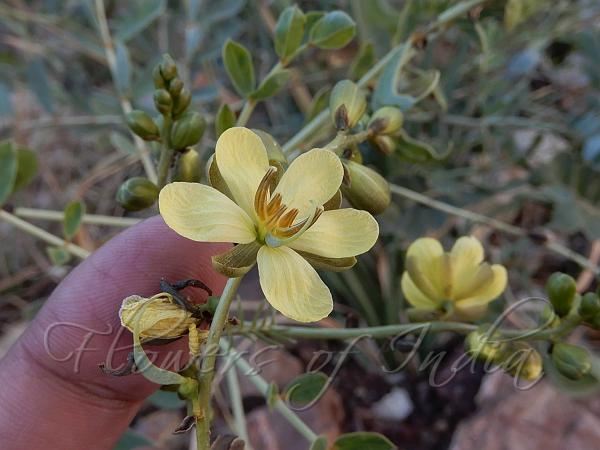|
| Italian Cassia |
|

|

| File size | 432934 |
| Original date | 12/10/19 6:33 PM |
| Resolution | 1900 x 1425 |
| Flash | Flash did not fire, auto |
| Focal length | 4.3mm |
| Exposure time | 1/50s |
| Aperture | 3.4 |
| Focus Distance | |
| Metering Mode | Center weighted average |
| Camera make | NIKON |
| Camera model | COOLPIX A900 |
| Sensor type |
|
|
|
|
Photo: |
Botanical name: Senna italica Family: Caesalpiniaceae (Gulmohar family)
Synonyms: Cassia italica, Cassia obtusa, Senna obovata
Synonyms: Cassia italica, Cassia obtusa, Senna obovata
Italian Cassia is a spreading perennial herb, 30-90 cm tall, stem hairless, pale green, branches hairless except the young parts. Leaves are 5-12 cm long, axis hairless, eglandular, leaf-stalk 1-3.5 cm long, stipules 6-7 mm long, leaflet 3-7 pairs, 1.8-3.5 cm long, 0.7-2 cm broad; broadly oblong or obovate, blunt, with a short sharp point, hairless on both sides or sometimes finely velvet-hairy beneath. Flowers are borne in stalked racemes about 6-23 cm in lea axils, flower-stalk about 2 mm long. Sepal-cup is 8-13 mm long, divided to the base, sepals oblong, blunt. Petals are 1-2 cm long, obovate to oblong, short clawed, yellow, netveined with darker veins. Perfect stamens are 7, unequal, 2 or 3 lowest larger, about 8-14 mm long. Pods are 2.5-4.5 cm long, about 1.2-1.8 cm broad, flat, thin, papery, hairless, rounded at both the ends, much recurved with a line of prominent longitudinal crest in the middle of the pod. Seeds are 6-12, wedge shaped about 6 mm long, about 3 mm broad, finely reticulate, rugose, with a transverse ridge across the middle of each face, dark brown. Italian Cassia is native to Africa to Indian Subcontinent.
Medicinal uses: The leaves, pods and seeds of
Senna italica are mostly used in traditional medicine. In Malawi, root
infusion is used to treat diarrhea in infants. In India, the leaves are
used as a hair treatment called neutral henna or “blonde henna”. This
treatment coats the hair so that it looks glossy and thick for several
weeks, but instead of being completely neutral, "neutral henna" appears
to have a yellowish impact on hair rather than the reddish one produced
by henna.
The leaves, pods and seeds of
Senna italica are mostly used in traditional medicine. In Malawi, root
infusion is used to treat diarrhea in infants. In India, the leaves are
used as a hair treatment called neutral henna or “blonde henna”. This
treatment coats the hair so that it looks glossy and thick for several
weeks, but instead of being completely neutral, "neutral henna" appears
to have a yellowish impact on hair rather than the reddish one produced
by henna.
Medicinal uses:
 The leaves, pods and seeds of
Senna italica are mostly used in traditional medicine. In Malawi, root
infusion is used to treat diarrhea in infants. In India, the leaves are
used as a hair treatment called neutral henna or “blonde henna”. This
treatment coats the hair so that it looks glossy and thick for several
weeks, but instead of being completely neutral, "neutral henna" appears
to have a yellowish impact on hair rather than the reddish one produced
by henna.
The leaves, pods and seeds of
Senna italica are mostly used in traditional medicine. In Malawi, root
infusion is used to treat diarrhea in infants. In India, the leaves are
used as a hair treatment called neutral henna or “blonde henna”. This
treatment coats the hair so that it looks glossy and thick for several
weeks, but instead of being completely neutral, "neutral henna" appears
to have a yellowish impact on hair rather than the reddish one produced
by henna. | Identification credit: P. Samydurai | Photographed in IIT Campus, Jodhpur, Rajasthan. |
• Is this flower misidentified? If yes,